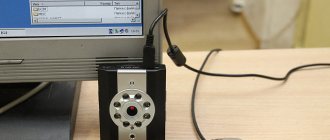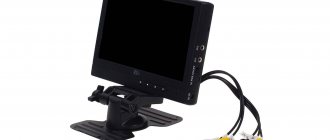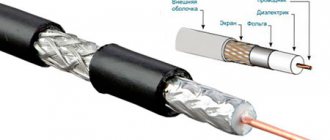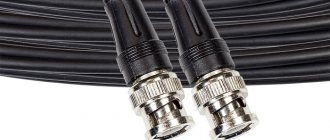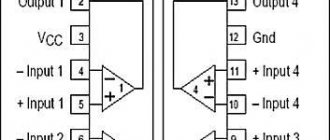Thanks to Wi-Fi technology available today, it is now possible to install a video surveillance system without using conventional cable lines. Wired cameras have been replaced by wireless Wi-Fi models. At first glance, they are much more convenient. Speed and ease of installation, as well as low cost, are their main advantages. But, despite all the advantages of wireless cameras, this type has never become widespread. Let's try to figure out why.
How does a Wi-Fi CCTV camera work?
The principle of operation of cameras is similar to a computer system, which uses routers, local networks and setting up routing through an online network.
The camera is considered a separate device with an IP address. It broadcasts video and audio signals, compressing information with video codecs for recording on media. It can be a DVR, a computer or a cloud service on the Internet.
The camera is powered by a power supply or a built-in battery. Models that are capable of recording data and storing it on a separate medium are also DVRs. Other types of cameras operate on a network, that is, they do not have a database of information storage.
The video stream is compressed by a built-in compressor: frames (MJPG) and streams (MPEG-4).
Some devices do not have compression elements, and information is transferred from the camera to the network using TCP and UDP network protocols.
Network elements:
- router (access point);
- power supply (standard or switching);
- separate DVR (depending on configuration);
- control panel (signal receiver).
Mechanism of operation
CCTV cameras are connected to a computer or other access point via a Wi-Fi network through routers and routers.
Additionally, software and drivers are installed. To configure the router, you need to register the IP address parameters with the DNS server.
The signal is divided into several categories regarding the range of influence:
- WPAN is a category of personal networks.
- WLAN – local wireless network.
- WMAN – direct transmission over long distances.
- WWAN – signal transmission at low speed.
Modern surveillance cameras operate based on the international standard 802.11. Depending on the subtype of standardization, the signal speed will decrease due to the distance when transmitting information.
You should also take into account the obstacle factor - waves are reflected from surfaces, for example, if they “meet” aluminum objects, an echo-like signal may appear. Therefore, for such cases, a repeater is used, which receives signals and transmits them to the next point.
The transmission speed will be reduced due to the time it takes to pass through the repeater.
To minimize risks, OFDM encoding is installed, which allows signals to pass through walls and basements.
Its principle is based on the formation of orthogonal signals.
Main functional features
Wireless IP camera - basic functionality
Modern IP cameras with WiFi have a number of unique characteristics that distinguish them from wired analog systems. Due to the ability to transmit signals without wires, as well as their compact size and high mobility, such cameras are very easy to install and, if necessary, easily change their location without the help of specialists. Most Wi-Fi cameras can work as an access point, which makes it easy to connect directly to them from a laptop, PC, or mobile phone over a wireless network and view the image from the camera. There are special applications for this that are suitable for all modern mobile and computer operating systems.
With the help of such cameras, you can easily set up broadcasting a video stream to the Internet - you just need to connect it to a router connected to a computer, enter the IP address in the browser (the IP address, as well as the username and password must be written in the instructions or on the bottom of the camera), perform all the necessary settings, then remove the cable from the camera and connect to it via Wi-Fi. Now all that remains is to configure the signal transmission to the Internet using a special program, which in some cases is included in the kit, or download it from the Internet.
Some devices are equipped with a motion sensor and IR illumination. The presence of the first allows you to start recording only after movement appears in the camera’s field of view, which saves disk space and also simplifies the task of viewing the archive. IR illumination, invisible to the human eye, makes it possible to conduct video surveillance even in complete darkness. As an additional option, the manufacturer sometimes implements the ability to record to an internal storage device – a Micro SD card. This function can be very useful in some situations, for example: if the signal is lost, the IP camera with WiFi will record what is happening on the card, so you will not miss anything important when the connection is lost. This can also be useful for offline recording of any event outside the home, or simple life moments.
In some cases, manufacturers of WiFi wireless security cameras equip them with a rotating mechanism that can be controlled remotely. Thanks to this feature, you can change the field of view of the camera as you please directly from your smartphone or computer.
If you want to install hidden video surveillance in your home, country house or office, you will need special miniature cameras. You can find out what models of hidden cameras exist today, as well as the nuances of their installation and possible problems with the law here.
Today there are miniature wireless cameras with WiFi and recording to a Micro SD card that easily fit in the palm of your hand and do not take up much space. They can be used for various needs, from autonomous recording of an event to creating covert surveillance. You can read about wireless mini video cameras using this link.
Wi-Fi CCTV camera device
The standard equipment of WIFI CCTV cameras consists of:
- power supplies, charging batteries, autonomous devices for operation when the network is disconnected (optional: the camera can be equipped with PoE connectivity);
- lens;
- night vision functions (optional: IR spotlights, mechanical or software infrared filters);
- speaker and microphone (optional);
- USB output port;
- slot for a removable memory card (optional).
IP cameras with Wi-Fi with online function
They can be manufactured in various form factors. Here are some of them:
- Dome devices. They resemble a hemisphere in shape. They are installed on the ceiling or similar surface. The durable casing used provides protection not only from mechanical damage, but also from moisture, dust and dirt. It is possible to hide for the observer the direction in which the shooting is currently taking place. The model has the appearance of a lamp or similar device for the purpose of camouflage.
- Rotary type. Equipped with a motion sensor that can detect the presence of strangers, automatically turn on and select the desired direction. This type of video camera is advantageous to use if the area to be monitored is small.
Connecting and setting up a Wifi camera: via a router, computer or phone
They can be self-contained and battery-powered, or use a standard electrical connection.
- Autonomous fire alarm sensors - operating principle and device design
Important! The ability to access the network allows you to receive them on any computer or smartphone in a browser.
Functions
Wi-Fi cameras are devices that broadcast video/audio data over the Internet or local network.
The image is transmitted in color and black and white. If there are problems with the network, Wi-Fi cameras continue to work offline.
Most models have the following functions:
- Ability to select the type of video stream formatting;
- Connect to the camera via a computer, phone, tablet;
- Elimination of signal interference;
- Noise reduction;
- Remote image recording setup;
- Remote activation/disabling of cameras;
- Data stabilization via EIS (anti-blurring);
- Vibration reduction.
Connecting and setting up wireless cameras
To install IP CCTV cameras with Wi-Fi, in most cases you need to follow these steps:
- Initially, you should connect the IP camera to the router via a UTP network cable;
- We connect the router to the computer using the same UTP cable;
- Then we enter the IP address of the camera in the address bar of any browser, and go to the settings - the IP address, login and password are usually indicated by the manufacturer on a sticker under the camera;
- Now we set up all the necessary parameters according to the instructions - wireless connection, type of video stream (adjusted based on the signal strength - the weaker the signal, the lower the picture resolution you need to select);
- Reboot the device, disconnect the network cable and connect via Wi-Fi;
- We install the software from the included disk, or download the necessary software for video surveillance on the Internet.
Scheme for connecting an IP camera to a PC via WiFi and creating access via the Internet
To provide remote access to the camera, you can use the service from IVideon. In free use there is a limit on the number of connected cameras of 2 pieces, which is quite enough for home use. Remote video surveillance using IVideon is provided by two free programs - Ivideon Server, and IVideon Client: the first is installed on the computer to which the Wi-Fi cameras will be directly connected, the second on the device from which you plan to conduct remote surveillance (the program can be installed on Android, iOS , and other modern OS). To install a large video surveillance system using this service, you need to select the appropriate tariff and pay for the services.
Video surveillance via the Internet today is implemented quite simply with the help of special cloud services. You can read more about creating remote access using the IVideon service in our article.
To organize your own video surveillance system, it would be a good idea to start by deciding on the type of cameras and other equipment. Learn about 5 simple ways to create video surveillance yourself.
IP cameras with Wi-Fi are quite easy to install with your own hands, but if you doubt your abilities, or are planning to connect a large-scale video surveillance system, then it is better to turn to specialists, because it makes more sense to pay a small amount once than to then hire the same specialists to fix your flaws in the installation and connection of the system. Good luck!
With this they read:
3G CCTV camera: main characteristics, features and selection criteria
Wireless WiFi CCTV Cameras
Wireless video surveillance kit: technical features and selection criteria
Wireless web camera with WiFi: moments of choice and examples of models
Did you like the article? Share with friends on social networks!
- Sergey
07/23/2016 at 20:32To cover the same area, you will need fewer rotating devices than static ones, but conventional cameras also have their advantages. Despite the ability of PTZ cameras to provide decent image quality and cover a large part of the territory, they are not capable of constant viewing, but only alternately display the situation in each area on the monitor screen for a short period of time. If this fact does not play a primary role, you can safely use a PTZ camera.
Reply ↓
Alexander Starchenko
(Post author)07/25/2016 at 11:45
Yes, of course, this feature has its place, but sometimes the advantages of PTZ cameras outweigh their disadvantages. In this article, I gave advice on using static cameras together with rotating cameras - when static cameras are installed to constantly monitor the territory, and one PTZ is additionally installed to quickly respond to unusual situations. Only in this case can maximum system efficiency be achieved.
11/13/2018 at 12:52
wireless cameras still need power cords... Unless, of course, it’s on a table and plugged in))) but then it’s no longer a security system...
Reply ↓
- Alexander
09.23.2019 at 17:24
Nowadays, outdoor battery-powered wifi cameras have appeared on sale, which are completely devoid of wires. The camera can operate on batteries for 2..3 months, after which it is necessary to change the 18650 battery(s) inside the camera. Quite a cool idea...
Pros and cons of Wi-Fi CCTV cameras
The advantages of Wi-Fi cameras include the ability to simultaneously connect several devices to one access point and more secure transmission of the video stream.
Mobility - if necessary, the device can be dismantled from one place and mounted in another without disconnecting from the network (provided that an autonomous power source is used).
Flaws:
- Basic knowledge is required in working with the network, setting up a router, setting up a DNS server, and registering an IP address.
- Over a large area (over 75-80 sq.m.) auxiliary routers and routers are required to enhance data transmission. Also, if you have additional devices, it is necessary to configure all signal passage points.
If a large number of video surveillance devices are installed, operating from the same network, then the throughput for each camera is reduced due to the load on the Wi-Fi network.
Outdoor IP camera with Wi-Fi support
This type of camera is made more secure. They are usually housed in a shockproof housing and will not be damaged by the elements. The quality of operation of these devices should minimally depend on the level of humidity, the presence of heat or frost, or strong wind outside.
- Security systems with facial recognition function: operating principle, installation and areas of application.
Connecting an IP camera to the Internet: remote configuration via the network
Typical characteristics of outdoor IP cameras are as follows:
- They provide protection against vandals.
- The body has increased strength.
- Possibility of heating.
- Using lens cleaners. This is necessary to ensure work outdoors in conditions of precipitation.
- Several operating modes are provided. These include daytime, nighttime, and the ability to discreetly shoot in infrared rays in the dark.
- The shooting range can be up to several hundred meters.
- Availability of a built-in microphone.
- It is possible to adjust the observation viewing angle. It can be a small area with maximum attention to detail, or it can cover a wide area so as to observe only the big picture.
Important! The image can be transmitted wirelessly or using twisted pair cable.
Filming can take place on an SD card, however, when choosing this option, you can take into account that it can be stolen from a video camera located separately on the street. Thus, transferring observation results from a 4G camera via a wireless network to cloud storage looks like a more convenient option.
Application
Wireless video surveillance systems are used indoors and outdoors; they are included in ready-made video surveillance kits (see Video surveillance kit for 8 cameras).
They were used at the following facilities:
- Residential buildings and plots, country cottages;
- Office and warehouse premises;
- Public places (parks, parking lots, recreation areas, gas stations);
- Construction projects;
- Educational and medical institutions;
- Tunnels, bridges;
- Train stations, airports.
Router in a video surveillance system
In the modern world of telecommunications, images from CCTV cameras can be observed while in another city if routers are installed in the system in question.
By configuring routers, you can achieve good picture quality. Thus, each video camera on your home network must have access to a virtual server. Thus, it is necessary to dial a specific router address and a specific forwarding port. The system requires the above procedures in cases where surveillance is carried out using multiple cameras.
The principle of operation of wi-fi CCTV cameras via a router
Module configuration. Included with the equipment in question, users are usually provided with a program for Wi-Fi CCTV cameras. With its help, you can correctly configure the module’s IP address and local network. Images are viewed using a LAN and the global Internet. But this process is carried out only if the camera has one of two types of IP addresses as an observation device. When this is not possible, users resort to DDNS technology. Then the information on the server is automatically updated, and the video surveillance camera is accessed through a domain address.
Modern models of the devices in question are suitable for connection via a patch cord if they support P2P technology. The setup here occurs by entering the device ID and password of the program itself, included in the package from the manufacturer. In this case, additional actions to improve the image will not be needed.
Exploitation
Before using the device, you need to test power supply and connect it to the router. The connection is made if you have a computer and a Wi-Fi network. Next, enter the network parameters. Camera drivers are installed on the computer, and the device is launched through a software package.
If there are two or more cameras, the connection is made to the same computer. Using the installed navigation software package, several devices are viewed simultaneously. The cameras are controlled - rotation, tilt angle, brightness and contrast.
Continuous recording (if such a function is available) of an image will require the maximum amount of memory (HDD). Therefore, it is necessary to use MJPEG, MPEG-4, H.264 codecs.
To increase the data transfer rate, it is advisable to reduce the image resolution and the number of frames to the minimum acceptable level.
During operation, you need to periodically check the devices for contamination and serviceability of the mechanisms.
Creating a Wireless Network
The central source directly involved in the operation of a CCTV camera is the Internet. However, for wireless operation, you need to connect a special router so that you can receive the video signal from a distance and send it to the monitor.
This router is directly connected to video cameras. You can monitor what is happening from anywhere, not only using a computer, but also a mobile phone. The main thing is that the components of the wireless network are configured for an Internet connection.
How does a w-ifi security camera work?
The principle of operation of a Wi-Fi camera is to transfer images to an IP video server online. In this case, you can record on additional media related to computer technology. If you plan to install one video camera, then you do not need a router or access point.
Today, there are several schemes that allow you to set up wireless video surveillance. The most popular is the connection of wi-fi cameras to a network video recorder via an access point.
Precautionary measures
To avoid voltage surges, uninterruptible power supply units (UPSUs) are installed.
To protect your information, it is recommended to hide the SSID (the name of your wireless network by which connected devices are identified) and periodically change the network access password.
General precautions:
- Operation at temperatures above 55 degrees is not recommended;
- Do not install cameras near heating devices;
- Avoid areas with strong electromagnetic radiation (high-voltage power lines);
- Do not install in areas with high humidity (unless the device is equipped with a pressure enclosure).
If the device is not visible on the computer, it is recommended: If PoE is available, check the functionality of the camera by connecting to it via cable. Check network settings (IP address).
If the device does not turn on during a long absence of electricity, you need to restart the camera and restore the network access settings.
Disadvantages of Wireless Cameras
The main disadvantages of Wi-Fi cameras: vulnerability to wireless network interference and the possibility of signal suppression. If your Internet connection is slow or unstable, it will be difficult to watch the broadcast. In addition, if direct access to it is required to disable a wired camera, a Wi-Fi camera can be disabled remotely using a signal suppressor.
An attacker can notice the antenna that such devices are often equipped with and turn on a “jammer” to create interference in the 2.4 and 5 GHz bands. Wireless transmission of images and sound will become impossible. The only way to avoid losing recorded data is to use cameras with parallel storage to a memory card. As a rule, MicroSD cards are used.
Another disadvantage is that the devices are not completely wireless. Despite the fact that information is transmitted via radio, a cable connection is required for power. Models with a battery are not so widespread; they are mainly used as wearable devices (chest cameras and video recorders).
Nowadays, many organizations use wi-fi video surveillance systems. After all, the method in question allows you, if desired, to view the video stream even at some distance. Moreover, a Wi-Fi camera eliminates the need for a special wired system, which significantly reduces installation costs.
Manufacturers and models of Wi-Fi CCTV cameras
Amcrest
Leading manufacturer of IP intercoms, video surveillance and communication systems. Specializes in the development of cameras for external and internal surveillance, walkie-talkies and audio equipment for listening to objects. Manufacturer from China, has established itself in the USA and Europe.
| Amcrest IP2M-841B | Amcrest IPM-721S | Amcrest IP2M-842 |
| View | ||
| Internal, rotating | Internal, rotating | External/internal with protected housing, rotating |
| Permission | ||
| 1080(TVL 1920) | 720(1280TVL) | 1080P(1920TVL) |
| Tilt angle | ||
| 90° | 85° | 72° |
| IR illumination | ||
| There is | There is | There is |
| Removable storage | ||
| There is | No | No |
Amcrest IP2M-841B - indoor night vision camera, Full HD 1080P video, 30 frames per second, configurable using iPhone or Android.
Amcrest IPM-721S – indoor video surveillance camera with two-way conversation, zoom, secure data transmission using AES encryption protocol.
Setting up CCTV cameras
Sometimes, after installing CCTV cameras, problems arise with their operation. Therefore, before starting installation, you should understand the general structure of the wi-fi camera.
So, the device in question consists of a processor, a matrix, a board, and connectors. This collection is usually called a module. The device works properly only if the light is correctly focused on the matrix. To accomplish this task, the wi-fi camera must be equipped with a lens.
Wi-Fi camera module
Camera board in housing
A set of components for assembling a wi-fi camera
Based on the method of attaching lenses, the following types of connections are distinguished:
- M12;
- C/CS.
The main difference between these connections is the amount of light passing through the camera lens. If you visit a specialized goods market, you will notice a large number of modifications of the C/CS type.
The first step is to adjust the focus of the video camera system by changing the distance from the sensor to the lens. Rotate the adjusting part on the body gradually, loosening the fixing screw. Although some camera models do not require adjustment, since the lens is initially fixed at the set point.
Photo
Analogue past and IP present
Today, when installing a high-definition video surveillance system, you basically have to choose from two options: analog (AHD, HDSDI, HDCVI) or IP.
In analog video surveillance systems, the video camera sends the video signal to the monitor directly without compression. These are easy to install, reliable, but cumbersome systems with limited functionality. Today, such solutions are mainly used only in small systems with several closely spaced cameras or in highly specialized industries. We will not consider analog video surveillance systems based on PAL/NTSC formats, developed more than 60 years ago. They are obsolete because they have a resolution of 720x480 and do not provide acceptable image quality, for example, for reliable recognition of a face or car license plate. Today the most popular analog format is AHD. It provides 720p (1280x720) and 1080p (1920x1080) resolutions, making analogue CCTV not completely a thing of the past and finding use in simple solutions.
Fig.1. Analog systems are built on the simple principle of direct video transmission
HDSDI, HDCVI also use HD cameras and can be based on old cable networks left over from analog systems. They are usually used for highly specialized tasks, for example in casino video surveillance systems, where real-time surveillance and video data protection come first.
Rice. 2. IP cameras are more flexible
Digital surveillance systems based on IP cameras use compressed video transmission over networks, including the Internet and wireless. Such systems are easily scalable, have many customizable parameters and broader functionality, for example, the ability to transmit high-resolution video at a high frame rate per second for clearly capturing fast-moving vehicles. Therefore, IP cameras are used in a wide variety of surveillance systems: from home systems with remote access to large-scale networks for monitoring nature reserves and city blocks.
Features of choosing wireless video surveillance cameras that transmit signals over Wi-Fi, 3G and GSM networks
Reading time: 8 minutes(s) Video surveillance systems today have become an integral element of facility security. In this case, various models are used: both with and without wires. Wireless CCTV cameras are easy and affordable to install and configure. They are cheaper than wired analogues, so they are in great demand. Interest in them is justified, since the use of wireless devices has many advantages.
What are wireless security cameras?
The camera is a wireless device for video recording of events. It has a certain range of action.
Events happening around are recorded on a storage device and accompanied by sound.
Why is it needed and where is it used?
Wireless video cameras or sets of wireless equipment are used where it is impossible to connect electricity: in hard-to-reach places, in transport. They are also used for monitoring and protecting private and public facilities.
Cameras of this type are used for:
- implementation of control and security,
- object observation,
- control of technical processes,
- monitoring highways, bridges, stations, etc.,
- video surveillance in transport,
- control in the trade sphere.
How it works: device and principle of operation
The main reason for the popularity of wireless video cameras is that they can be used almost anywhere, even discreetly if necessary. Such a camera consists of a housing, a transmitter installed inside, and a receiver. They also have a 12 V DC source (battery), an antenna and a cable for connecting the receiver to the equipment.
If CCTV recording is required, a recorder is also included. The signal receiver is connected to a computer or TV monitor. The connection between the video transmitter and the receiver is very powerful and can reach several kilometers.
Depending on the quality of the camera, the signal passes through various obstacles, walls, glass, wood, plastic. Image quality depends on the distance and placement of the camera.
Existing types
Wireless video cameras can be divided into several types based on the principle of data transmission.
- Analog. The principle of operation and structure are the same as in terrestrial television. Using a matrix, video data is processed into an electrical signal and sent to the transmitter.
- GSM, 3G cameras.
The signal is transmitted through the network via mobile communications. The range is determined by the coverage of the operator of a given network. - WiFi or IP cameras. The device has its own IP address, through which communication with the receiver occurs. The operating principle is the same as for all mobile devices.
- Webcams. The equipment operates according to a special program and includes a camera, transmitter, receiver and converter.
Reviews of modern wireless surveillance cameras: pros and cons
Wireless security cameras are well established and many people have been using them for a long time. But, like any other device, they have their positive and negative sides.
Advantages:
- no need for wires and cables;
- possibility of hidden placement;
- easy installation;
- device mobility;
- transmission of information via mobile network;
- high signal quality.
Flaws:
- high price;
- weak signal in the presence of other devices or obstacles;
- Additional equipment is required in the case of creating a multi-channel system.
Manufacturers and popular models: ranking of the best and prices
Standard for apartments and houses
- VStarcam C7812WIP
Compact video camera with an expanded range of functions. There is an application in Russian for working with the device. Features of the model: easy installation and viewing from mobile devices using Plug and play technology, suitable for installation in any video surveillance systems, HD video quality (1280*720 pixels).Has a built-in motion sensor
IR illumination up to 15 meters, viewing angle - 56o, support for P2P technologies and Onvif and RTSP protocols for integration with network recorders. Manufacturer - China, price - 4750 rubles.
- Redmond SkyCam RG-C1S
The video camera operates using Wi-Fi wireless technology and has an unlimited range. The main functions of the device: real-time control and surveillance, two-way voice communication, video recording and image saving. It has a motion sensor and is controlled remotely from a smartphone via the R4S Home mobile application on iOS and Android. Several cameras can be connected to one application.The camera displays clear color video and high-quality sound.
Manufacturer - China, price - 3999 rubles.
- TP-LINK NC220
Wireless cloud camera designed for 24/7 surveillance. The video runs at a speed of 300 Mbit/s.You can view using the tpCamera application on any mobile device.
The motion and sound sensor works. Maximum video resolution 640*480 pixels, OS support (Android, iOS, Windows, MacOC), Wi-fi available. Range -5.5 m, viewing angle - 68o, installation can be any (ceiling, wall, table). Manufacturer - China, price - 3590 rubles.
- IVUE B1, 1.0Mpx
One of the best CCTV cameras, wireless Wi-fi, IP camera. It has an automatic mode for switching the time of day, a display resolution of 1280*720 pixels, and a camera resolution of 1 MPX.
Compatible with Android, iPhone, iPad.
There is IR illumination at night up to 20 m, operating temperature from -30 to +50 ° C, built-in motion sensor, wireless data transmission. Manufacturer - China, price - 4990 rubles.
- DAHUA DH-IPC-HDBW1120EP-W-0280B
The wireless dome camera has advanced technical characteristics: equipped with a CMOS 1/3 1.3 MP matrix, frame rate 25 fps with a resolution of 1280*960, encoding in H.264 and MJPEG formats, has a day/night shooting mode, a fixed lens focal length 2.8 mm, Wi-fi.
IR illumination range - 20 m
The viewing angle is 89o, there is a built-in microphone. Manufacturer - China, price - 6790 rubles.
Mini surveillance cameras
- Ambertek DV135S
One of the best stand-alone covert video surveillance cameras. The mini video camera is made of metal and plastic and has a convenient mount for wearing on clothing. Distinctive features of the device: records HD video with a resolution of 1920*1080 pixels and a frequency of up to 60 fps, has an HDMI output that allows you to connect it directly to your TV.In addition to video, it can take high-quality photographs.
The built-in motion sensor has high sensitivity, even when shooting at night up to 5 m. Viewing angle - 170o, battery for 1.5 hours of continuous operation, built-in motion sensor. Manufacturer - Taiwan, price - 8980 rubles.
- Ai-Ball Blue
A miniature Wi-fi camera allows you to shoot video and view it on iOS or Android mobile devices, or simply on a computer. The advantages of this model are its small size (30*35 mm) and light weight (11 g without battery). Maximum recording resolution VGA 640*480, viewing angle 60°, operating temperature - from 0 to 55°C.The camera connects to the Internet via Wi-fi.
Multiview mode allows you to monitor from several cameras at once. Manufacturer - China, price - 4875 rubles.
- MD81 Mini WiFi P2P Camera
The device is very small and looks like a flash drive. This makes it easy to attach to clothing and any vertical or horizontal surface.The camera interacts with any mobile devices, as it has a Wi-fi connection.
Maximum video resolution - 640*480 pixels, frame rate - 10 fps, range - 15 m, 2 GB memory card, support for iOS and Android OS. Manufacturer - China, price - 3200 rubles.
Which manufacturer and which type is better to choose: TOP-3
- IVUE B1, 1.0Mpx is one of the best outdoor video surveillance cameras. Advantages: waterproof and frost-resistant housing, IR filter to improve image quality and backlight for night shooting up to 20 m, built-in motion sensor and data transmission via Wi-fi. China, price - 4990 rubles.
- Ambertek DV135S is a very popular mini camera with advanced functionality. Convenient format, high-resolution photos and videos, lithium-polymer battery, wide viewing angle - this is not a complete list of the excellent characteristics of the device. Taiwan, price - 8980 rubles.
- MD81 Mini WiFi P2P Camera - a video camera with Wi-fi can connect to the Internet from anywhere in the world. The case is made in the form of a flash drive, which allows for covert surveillance. It can work while charging, and can also connect up to 4 cameras to the network simultaneously. Quick setup and broadcast video from any mobile device. China, price - 3200 rubles.
What to consider when choosing a device?
There are several criteria by which you can choose a wireless security camera.
- Digital or analog.
Analog cameras work with NTSC or PAL signals and connect directly to the monitor. Digital cameras transcode the received data into a digital signal and transmit it to a computer cloud server via Wi-fi. Digital cameras have a much higher video resolution (1920*1080) than analog cameras (720*576). - Outdoor or indoor.
In case of outdoor installation, it is necessary that the camera body is protected from weather and mechanical influences, as well as from frost and moisture. Cameras are installed as high as possible to protect them from damage. Indoor cameras may not have protective housings. - Lens focal length and viewing angle.
Cameras with wide viewing angles and short focal lengths provide a general overview of the area. For remote monitoring or for shooting a small space, cameras with a long focal length lens and a viewing angle of no more than 45o are required. There are special cameras that can change the viewing angle. They are called varifocal. - Image quality. The number of pixels is an important factor for video resolution, and therefore image quality. But the sensitivity of the matrix and the ability of the camera to operate in a wide dynamic range are also important.
- Camera sensitivity and lighting. Sensitivity is an important characteristic, since image quality depends on it. The higher it is, the better. Light sensitivity is measured in lux.
For a high-quality camera with the ability to work around the clock, the photosensitivity should be at least 0.01 lux.Also, most cameras have IR illumination, which is also very important for night photography. For outdoor cameras, automatic iris adjustment is important so that it adjusts according to bright light or darkness.
- WDR technology.
This is the name given to the camera's wide dynamic range. It allows you to get the same level of illumination of faces, darkened objects, and backgrounds. Usually WDR is only available in expensive models. - IR illumination and shooting day or night.
Infrared radiation allows you to shoot even at night, in complete darkness. The more powerful it is, the better. It is very convenient if the camera has an automatic day/night transition mode. Then when the time of day changes, it will switch itself.
Three best models
- Orient 804A-24. Designed for observation in hard-to-reach places. Suitable for indoor and outdoor surveillance. It has 10 infrared diodes for illumination in the dark, as well as a light sensor. Minimum illumination - 2 LUX, range - up to 50 m. Manufacturer - Japan, price - 4500 rubles.
- ESCAM QF001. PTZ wireless Wi-fi camera. It has a wide viewing angle (355o), motion sensor, IR illumination, built-in speaker and microphone, device control and video viewing via mobile applications. Manufacturer - China, price - 4500 rubles.
- Wi-fi micro camera Q-11 NIGHT. Thanks to wi-fi, it can conduct remote monitoring, a viewing angle of 140°, it has the ability to record Full HD, it works without recharging for 25 hours, it has night shooting functions and a motion detector. Price - 10990 rubles.
Recommendations for placement
The operation of the entire video surveillance system depends on the correct placement of video cameras.
Internal placement.
- For a small room, one camera with a wide viewing angle installed in a corner on the ceiling is enough.
- You need to install the camera so that light from a window or lamp does not fall directly into the lens. Windows should be to the side or rear of the camera.
Outdoor surveillance.
- To install outdoors, the device must be protected from moisture, frost, dust and mechanical influences.
- The height should be optimal, above 3 m.
If installed low, the camera may be stolen or damaged; if installed high, objects will be difficult to see. - It is advisable that direct sunlight, as well as the light of lanterns or spotlights, does not enter the lens, otherwise the image will be overexposed.
- For better night photography, you need to choose a camera with high light sensitivity, or install additional flashlights.
Price
The cost of a wireless video surveillance camera depends on its technical parameters: light sensitivity, range and viewing angle, IR illumination, the presence of Wi-fi and a motion sensor. The type of camera matters: analog or digital, intended for outdoors or indoors.
The cheapest models cost from 3,000 to 5,000 rubles.
- VStarcam C7812WIP - 4750 rubles.
- Redmond SkyCam RG-C1S - 3999 rubles.
- TP-LINK NC220 - 3590 rubles.
- IVUE B1, 1.0Mpx - 4990 rubles.
- Ai-Ball Blue - 4875 rubles.
- MD81 Mini WiFi P2P Camera - 3200 rubles.
- Orient 804A-24 - 4500 rubles.
- ESCAM QF001 - 4500 rubles.
More expensive models can cost from 7,000 to 11,000 rubles.
- DAHUA DH-IPC-HDBW1120EP-W-0280B — 6790 rubles.
- Ambertek DV135S - 8980 rubles.
- Wi-fi micro camera Q-11 NIGHT - 10,990 rubles.
Where to buy a standalone wireless security camera?
In Moscow
- Online store of video equipment VIDEO-SFERA, Simonovsky Val, 7, building 2,
- CamDrive company, st. Miklouho-Maklaya, vlad.8, building 3, 7(495)540-53-73
- NanoZoom company, Pyatnitskoe highway, 18,
In St. Petersburg
- STARCAM company, st. Salova, 53,
- Online electronics store AVT-Tekhnika, Izmailovsky pr., 4, office 246,
- , st. Bumazhnaya, 16, office 223, 7(812)426-30-50
Wireless CCTV cameras are easy to design and install and are accessible to everyone, which is why their popularity is growing. The use of modern technologies opens up even more opportunities. Selecting the video camera you need will not be difficult; the main thing is to correctly correlate the purpose of the purchase with the capabilities of the equipment.
Did this article help you? We would be grateful for your rating:
0 0
